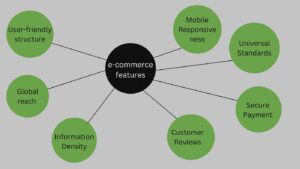In today’s digital age, an e-commerce website is essential for businesses looking to reach a broader audience and increase sales. However, simply having an online store is not enough. To stand out in the competitive market, your e-commerce website must be equipped with essential features that enhance user experience, streamline operations, and drive conversions. Here are ten crucial features every e-commerce website should have.
1. User-Friendly Design
Intuitive Navigation
A user-friendly design is the cornerstone of any successful e-commerce website. Ensure your site has an intuitive navigation system that allows users to find products easily. Use clear categories, subcategories, and a search bar to help visitors locate what they need quickly.
Mobile Responsiveness
With an increasing number of shoppers using mobile devices, your website must be mobile-responsive. This means it should automatically adjust to different screen sizes and provide a seamless browsing experience on smartphones and tablets.
2. High-Quality Product Images and Descriptions
Visual Appeal
High-quality images are vital as they give customers a clear view of the product. Provide multiple images from different angles and include a zoom-in feature to allow detailed inspection.
Detailed Descriptions
Accompany your images with detailed product descriptions. Include information about the size, color, material, and any other relevant specifications. Clear and concise descriptions help customers make informed purchasing decisions and reduce the likelihood of returns.

3. Secure Payment Gateway
Multiple Payment Options
Offer a secure and diverse range of payment options to cater to different customer preferences. Common options include credit/debit cards, PayPal, and digital wallets like Apple Pay or Google Pay. Ensure that your payment gateway is encrypted and PCI-DSS compliant to protect customer information.
Easy Checkout Process
Simplify the checkout process by minimizing the number of steps required to complete a purchase. An optimized checkout process reduces cart abandonment rates and enhances user satisfaction.
4. Customer Reviews and Ratings for E-commerce website
Build Trust
Customer reviews and ratings are crucial for building trust and credibility. Allowing customers to leave reviews provides social proof that can influence potential buyers. Positive feedback can significantly boost your sales, while constructive criticism offers valuable insights for improvement.
Verified Purchases
Implement a system to verify that reviews come from actual buyers. This adds authenticity to the feedback and helps potential customers make confident purchasing decisions.
5. Effective Search Functionality
Advanced Search Options
An effective search functionality is essential for helping users find products quickly. Include filters and sorting options to refine search results based on criteria like price, popularity, and ratings. An autocomplete feature can also enhance the user experience by suggesting products as users type their queries.
6. Wishlist and Save for Later
Customer Convenience
A wishlist feature allows customers to save products they are interested in for future reference. This can increase the likelihood of return visits and future purchases. It also provides valuable insights into customer preferences and popular products.
Personalized Experience
Allow users to share their wishlists with friends and family. This can drive more traffic to your site and potentially lead to increased sales, especially during holiday seasons and special occasions.
7. Detailed Order Tracking
Transparency
Provide detailed order tracking to keep customers informed about the status of their purchases. Send regular updates via email or SMS about order confirmation, shipping status, and delivery. This transparency enhances customer trust and satisfaction.
8. Robust Customer Support
Multiple Channels
Offer robust customer support through multiple channels such as live chat, email, and phone. An AI-powered chatbot can handle common queries instantly, while live agents can assist with more complex issues.
FAQ Section
Include a comprehensive FAQ section that addresses common questions and concerns. This can reduce the volume of support inquiries and provide quick solutions to customers.
9. Personalized Recommendations
Increase Sales
Use AI and machine learning to analyze customer behavior and recommend products based on their browsing history and previous purchases. Personalized recommendations can increase sales by showcasing relevant products that customers might be interested in.
Enhanced User Experience
Providing a personalized shopping experience makes customers feel valued and understood, encouraging repeat visits and loyalty.
10. Social Media Integration
Engage Customers
Integrate your e-commerce website with social media platforms like Facebook, Instagram, and Twitter. This allows customers to share their favorite products with their networks, driving more traffic to your site.
Social Proof
Display social media feeds or customer photos using your products directly on your website. This serves as social proof and can inspire other visitors to make purchases.
Conclusion
Incorporating these essential features into your e-commerce website can significantly enhance user experience, increase customer satisfaction, and drive sales. As the e-commerce landscape continues to evolve, staying ahead of the competition requires constant innovation and adaptation. By focusing on these key elements, you can create a robust and user-friendly online store that meets the needs of today’s savvy consumers.
For expert advice and services to optimize your e-commerce website, visit Tech-Outsource. If you need personalized assistance, don’t hesitate to Contact Us. We’re here to help you succeed in the competitive e-commerce market.






